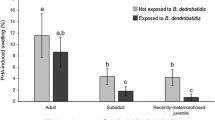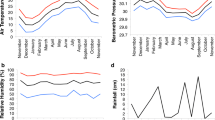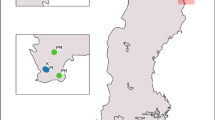Abstract
Emerging pathogens can drive evolutionary shifts in host life-history traits, yet this process remains poorly documented in vertebrate hosts. Amphibian chytridiomycosis, caused by infection with the fungal pathogen Batrachochytrium dendrobatidis (Bd), is the worst recorded wildlife disease and has caused the extinction of over 100 species across multiple continents. A similar number of additional species have experienced mass declines and Bd remains a major source of mortality in many populations of declined species now persisting with the pathogen. Life-history theory predicts that increased extrinsic mortality in Bd-infected populations may alter amphibian life-history traits, but this has not been examined. Here, we investigate whether population Bd status is associated with age and size at maturity by comparing long-exposed Bd-infected populations, Bd-free populations, and museum specimens collected prior to Bd emergence for the endangered Australian frog Litoria verreauxii alpina. We show that Bd-infected populations have a higher proportion of males that mature at 1 year of age, and females that mature at 2 years of age, compared to Bd-free populations. Earlier maturation was associated with reduced size at maturity in males. Consistent with life-history theory, our findings may represent an adaptive evolutionary shift towards earlier maturation in response to high Bd-induced mortality. To our knowledge, this study provides the first evidence for a post-metamorphic Bd-associated shift in an amphibian life-history trait. Given high mortality in other Bd-challenged species, we suggest that chytridiomycosis may be a substantial new selection pressure shaping life-history traits in impacted amphibian species across multiple continents.


Similar content being viewed by others
References
Allendorf FW, Hard JJ (2009) Human-induced evolution caused by unnatural selection through harvest of wild animals. Proc Natl Acad Sci USA 106:9987–9994
Altizer S, Harvell D, Friedle E (2003) Rapid evolutionary dynamics and disease threats to biodiversity. Trends Ecol Evol 18:589–596
Bakar AA, Bower DS, Stockwell MP, Clulow S, Clulow J, Mahony MJ (2016) Susceptibility to disease varies with ontogeny and immunocompetence in a threatened amphibian. Oecologia 181:997–1009
Barton K (2011) MuMIn: Multi-model inference, package version 1.0. 0. http://cran.r-project.org/. Accessed 14 Sept 2016
Bataille A et al (2015) Susceptibility of amphibians to chytridiomycosis is associated with MHC class II conformation. Proc R Soc Lond Ser B Biol Sci 282:20143127
Bates D, Maechler M (2010) lme4: linear mixed-effects models using S4 classes, package version 0.999375-33. http://cran.r-project.org/. Accessed 14 Sept 2016
Berger L et al (1998) Chytridiomycosis causes amphibian mortality associated with population declines in the rain forests of Australia and Central America. Proc Natl Acad Sci USA 95:9031–9036
Berkeley SA, Hixon MA, Larson RJ, Love MS (2004) Fisheries sustainability via protection of age structure and spatial distribution of fish populations. Fisheries 29:23–32
Brannelly LA et al (2015a) Chytrid infection and post-release fitness in the reintroduction of an endangered alpine tree frog. Anim Conserv 19:153–162
Brannelly LA, Hunter DA, Lenger D, Scheele BC, Skerratt LF, Berger L (2015b) Dynamics of chytridiomycosis during the breeding season in an Australian alpine amphibian. PLoS One. doi:10.1371/journal.pone.0143629
Briggs CJ, Knapp RA, Vredenburg VT (2010) Enzootic and epizootic dynamics of the chytrid fungal pathogen of amphibians. Proc Natl Acad Sci USA 107:9695–9700
Bronikowski AM (2000) Experimental evidence for the adaptive evolution of growth rate in the garter snake Thamnophis elegans. Evolution 54:1760–1767
Burnham KP, Anderson DR (2002) Model selection and multi-model inference: a practical information-theoretic approach. Springer, New York
Cole LC (1954) The population consequences of life history phenomena. Q Rev Biol 29:103–137
Fahrig L, Rytwinski T (2009) Effects of roads on animal abundance: an empirical review and synthesis. Ecol Soc 14:21
Felton A, Alford RA, Felton AM, Schwarzkopf L (2006) Multiple mate choice criteria and the importance of age for male mating success in the microhylid frog, Cophixalus ornatus. Behav Ecol Sociobiol 59:786–795
Fitzpatrick SW, Torres-Dowdall J, Reznick DN, Ghalambor CK, Funk WC (2014) Parallelism isn’t perfect: could disease and flooding drive a life-history anomaly in Trinidadian guppies? Am Nat 183:290–300
Gandon S, Agnew P, Michalakis Y (2002) Coevolution between parasite virulence and host life-history traits. Am Nat 160:374–388
Garner TW et al (2009) Life history tradeoffs influence mortality associated with the amphibian pathogen Batrachochytrium dendrobatidis. Oikos 118:783–791
Greenspan SE, Roznik EA, Schwarzkopf L, Alford RA, Pike DA (2016) Robust calling performance in frogs infected by a deadly fungal pathogen. Ecol Evol 6:5964–5972
Grogan LF et al (2016) Endemicity of chytridiomycosis features pathogen over-dispersion. J Anim Ecol 85:806–816
Heard GW, Scroggie MP, Clemann N, Ramsey DSL (2014) Wetland characteristics influence disease risk for a threatened amphibian. Ecol Appl 24:650–662
Hettyey A, Pearman PB (2003) Social environment and reproductive interference affect reproductive success in the frog Rana latastei. Behav Ecol 14:294–300
Hothorn T, Bretz F, Westfall P, Heiberger R, Schuetzenmeister A, Scheibe S (2013) multcomp: simultaneous inference in general parametric models, package version 1.3-0. http://cran.r-project.org/. Accessed 14 Sept 2016
Hunter DA, Pietsch R, Clemann N, Scroggie M, Hollis G, Marantelli G (2009) Prevalence of the amphibian chytrid fungus (Batrachochytrium dendrobatidis) in populations of two frog species in the Australian Alps. Report to the Australian Alps Liaison Committee: January 2009
Jones ME et al (2008) Life-history change in disease-ravaged Tasmanian devil populations. Proc Natl Acad Sci USA 105:10023–10027
Knapp RA et al (2016) Large-scale recovery of an endangered amphibian despite ongoing exposure to multiple stressors. Proc Natl Acad Sci USA 113:11889–11894
Kuparinen A, Merilä J (2007) Detecting and managing fisheries-induced evolution. Trends Ecol Evol 22:652–659
Lampo M, Celsa SJ, Rodriguez-Contreras A, Rojas-Runjaic F, Garcia CZ (2012) High turnover rates in remnant populations of the Harlequin frog Atelopus cruciger (Bufonidae): low risk of extinction? Biotropica 44:420–426
Longo AV, Burrowes PA, Zamudio KR (2014) Genomic studies of disease-outcome in host–pathogen dynamics. Integr Comp Biol 54:427–438
McDonald KR, Mendez ID, Muller R, Freeman AB, Speare R (2005) Decline in the prevalence of chytridiomycosis in frog populations in North Queensland, Australia. Pac Conserv Biol 11:114–120
Morrison C, Hero JM (2003) Geographic variation in life-history characteristics of amphibians: a review. J Anim Ecol 72:270–279
Muths E, Scherer RD, Pilliod DS (2011) Compensatory effects of recruitment and survival when amphibian populations are perturbed by disease. J Appl Ecol 48:873–879
Newell DA, Goldingay RL, Brooks LO (2013) Population recovery following decline in an endangered stream-breeding frog (Mixophyes fleayi) from subtropical Australia. PLoS One. doi:10.1371/journal.pone.0058559
Newman RA (1998) Ecological constraints on amphibian metamorphosis: interactions of temperature and larval density with responses to changing food level. Oecologia 115:9–16
Ohlberger J et al (2011) Pathogen-induced rapid evolution in a vertebrate life-history trait. Proc R Soc Lond Ser B Biol Sci 278:35–41
Osborne W, Hunter D, Hollis G (1999) Population declines and range contraction in Australian alpine frogs. In: Campbell A (ed) Declines and disappearances of Australian frogs. Environment Australia, Canberra, pp 145–157
Phillott AD, Grogan LF, Cashins SD, McDonald KR, Berger L, Skerratt LF (2013) Chytridiomycosis and seasonal mortality of tropical stream-associated frogs 15 years after introduction of Batrachochytrium dendrobatidis. Conserv Biol 27:1058–1068
Puschendorf R et al (2009) Distribution models for the amphibian chytrid Batrachochytrium dendrobatidis in Costa Rica: proposing climatic refuges as a conservation tool. Divers Distrib 15:401–408
Reznick DA, Bryga H, Endler JA (1990) Experimentally induced life-history evolution in a natural population. Nature 346:357–359
Roff D (1993) Evolution of life histories: theory and analysis. Springer, Berlin
Romiguier J et al (2014) Comparative population genomics in animals uncovers the determinants of genetic diversity. Nature 515:261–263
Rouyer T, Sadykov A, Ohlberger J, Stenseth NC (2012) Does increasing mortality change the response of fish populations to environmental fluctuations? Ecol Lett 15:658–665
Roznik EA, Sapsford SJ, Pike DA, Schwarzkopf L, Alford RA (2015) Condition-dependent reproductive effort in frogs infected by a widespread pathogen. Proc R Soc Lond Ser B Biol Sci 282:20150694
Ryan MJ (1988) Energy, calling, and selection. Am Zool 28:885–898
Saether BE, Bakke O (2000) Avian life history variation and contribution of demographic traits to the population growth rate. Ecology 81:642–653
Sapsford SJ, Voordouw MJ, Alford RA, Schwarzkopf L (2015) Infection dynamics in frog populations with different histories of decline caused by a deadly disease. Oecologia 179:1099–1110
Scheele BC, Guarino F, Osborne W, Hunter DA, Skerratt LF, Driscoll DA (2014a) Decline and re-expansion of an amphibian with high prevalence of chytrid fungus. Biol Conserv 170:86–91
Scheele BC et al (2014b) Interventions for reducing extinction risk in chytridiomycosis-threatened amphibians. Conserv Biol 28:1195–1205
Scheele BC, Hunter DA, Skerratt LF, Brannelly LA, Driscoll DA (2015) Low impact of chytridiomycosis on frog recruitment enables persistence in refuges despite high adult mortality. Biol Conserv 182:36–43
Scheele BC et al (2016a) High adult mortality in disease-challenged frog populations increases vulnerability to drought. J Anim Ecol 85:1453–1460
Scheele BC, Hunter DA, Brannelly LA, Skerratt LF, Driscoll DA (2016b) Reservoir host amplification of disease impact in an endangered amphibian. Conserv Biol. doi:10.1111/cobi.12830
Scheele BC et al (2017) After the epidemic: ongoing declines, stabilizations and recoveries in amphibians afflicted by chytridiomycosis. Biol Conserv 206:37–46
Skerratt LF et al (2007) Spread of chytridiomycosis has caused the rapid global decline and extinction of frogs. EcoHealth 4:125–134
Skerratt L et al (2016) Priorities for management of chytridiomycosis in Australia: saving frogs from extinction. Wildl Res 43:105–120
Stearns SC (1992) The evolution of life histories. Oxford University Press, Oxford
Stearns S, Ackermann M, Doebeli M, Kaiser M (2000) Experimental evolution of aging, growth, and reproduction in fruitflies. Proc Natl Acad Sci USA 97:3309–3313
R Development Core Team (2016) R: a language and environment for statistical computing. Vienna: R Foundation for Statistical Computing. http://www.R-project.org. Accessed 11 July 2016
Tobler U, Borgula A, Schmidt BR (2012) Populations of a susceptible amphibian species can grow despite the presence of a pathogenic chytrid fungus. PLoS One. doi:10.1371/journal.pone.0034667
Wake DB, Vredenburg VT (2008) Are we in the midst of the sixth mass extinction? A view from the world of amphibians. Proc Natl Acad Sci USA 105:11466–11473
Wilbur HM, Rudolf VH (2006) Life-history evolution in uncertain environments: bet hedging in time. Am Nat 168:398–411
Woinarski JC, Burbidge AA, Harrison PL (2015) Ongoing unraveling of a continental fauna: decline and extinction of Australian mammals since European settlement. Proc Natl Acad Sci USA 112:4531–4540
Acknowledgements
Funding was provided by a Taronga Zoo Field Conservation Grant and the New South Wales Office of Environment and Heritage. B.C. Scheele and L. Berger were supported by Australian Research Council Grants LP110200240 and FT100100375, which included additional funding from industry partners Taronga Zoo and New South Wales Office of Environment and Heritage during the writing of this manuscript. C. Scheele and S. Kearney provided field assistance, K. Smith and L. Brannelly helped facilitate museum sampling, and C. Foster provided statistical advice and helped with figures. All applicable institutional and/or national guidelines for the care and use of animals were followed, with research conducted under scientific permits SL100436 and SL10006052 issued by the New South Wales Office of Environment and Heritage and animal ethics approval from the Australian National University (A2011/19) and the University of Canberra (CEAE 98/7).
Author information
Authors and Affiliations
Contributions
BCS, LFS, DAH, JCP, DAD, SCB, PGB, and LB conceived and designed the research. BCS and DAH performed field and laboratory work. BCS analysed data. BCS wrote the manuscript and all authors contributed editorial advice.
Corresponding author
Additional information
Communicated by Herwig Leirs.
Electronic supplementary material
Below is the link to the electronic supplementary material.
Rights and permissions
About this article
Cite this article
Scheele, B.C., Skerratt, L.F., Hunter, D.A. et al. Disease-associated change in an amphibian life-history trait. Oecologia 184, 825–833 (2017). https://doi.org/10.1007/s00442-017-3911-7
Received:
Accepted:
Published:
Issue Date:
DOI: https://doi.org/10.1007/s00442-017-3911-7




